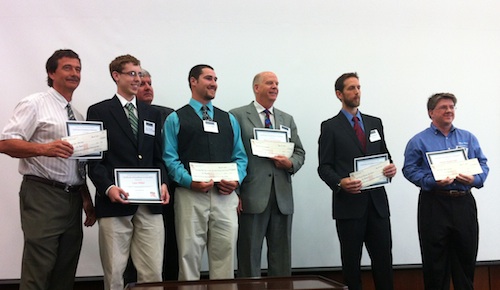 Hello again! When I wrote my blog post on my experiences as one of the Educator Winners from the 2012 STEM Video Game Challenge, I didn’t have a chance to discuss my method for designing games for students. I’ve thought about this quite a bit, and wanted to share some of my tips with other aspiring game designers here.
Hello again! When I wrote my blog post on my experiences as one of the Educator Winners from the 2012 STEM Video Game Challenge, I didn’t have a chance to discuss my method for designing games for students. I’ve thought about this quite a bit, and wanted to share some of my tips with other aspiring game designers here.
First, there are two good articles on video games and learning at the STEM Challenge website at the bottom of their Resources page. These two documents provided great insight for me while I was writing the research document for the STEM Challenge. I believe these documents are a good place to start if you are interested in making a game or already have an idea.
Thinking about the types of games you like to play is another starting point. I’ve been playing card, board, and computer games, plus math and number puzzles ever since I was in elementary school. Many of my ideas for making a new game are inspired by games that I have seen or played before. Researching (and playing) many types of board games, puzzles, and strategy computer games provide ideas on gameplay and mechanics.
I also think a lot about the purpose of the game; is the game to teach, practice, or apply a specific concept? I think that a “teaching” game is the hardest—simply because the “game” is focused on teaching, and not game play; so I would consider that to be online or computer-based learning, not necessarily a game.
Practice games focus on a concept to build fluency—speed and accuracy in the content, usually implying repetition and a time element, much of which drove the design of AdditionBlocks. Even in very simple addition or subtraction game, or even to more complicated, higher-level concepts, I believe students would much rather play a game than do a work sheet! However, keep in mind that players will be at all different stages of ability, understanding and knowledge…so adding speed or difficulty levels will keep the game playable for everyone. Students also need the freedom to fail (get a wrong answer) and to continue playing without being penalized too much (or even at all!). Instead, I focus on the reward (i.e., points gained) for getting correct answers.
I think, however, that an application game is the most interesting. An application-type game would be a strategy game, puzzle-solving (think “Lure of the Labyrinth”) or a simulation. Although these types of games are definitely the most time-consuming and complicated to create, application games allow for more open-ended answers, building critical-thinking and problem-solving skills, strategic planning, and higher-level thinking.
Lastly, Keep it simple! Do not put too many concepts into the game. AdditionBlocks focuses on one concept: addition. This will make the development much easier. Even in simulation/application type games, once the creation process begins, I find it easy to get carried away by adding different features and game play. Get a game out there and have your students play it! Get feedback from them and then put in new features in version 2.0.
The AdditionBlocks game came to being in a burst of creative inspiration, and the rest was time, effort, and energy into brainstorming, developing, and debugging the game. It takes perseverance, revising, overcoming setbacks, and plenty of play-testing. To paraphrase Thomas Edison, AdditionBlocks was “1% inspiration and 99% perspiration”.
Martin Esterman teaches seven grade math for the STEM Magnet program at Marietta Middle School in Marietta, Georgia. He has been with MMS for 10 years and has taught all levels of math learners-from advanced students two grades ahead to students below grade level. He has designed, implemented, and used all types math games and number puzzles in his classes at every level. Before teaching, he was a software engineer for seven years. Martin was awarded the Outstanding New Employee at Marietta Middle School in 2002, and recognized as one of the initial Georgia Master Teachers by the Georgia Department of Education in 2005. He is the winner of the PBS Kids Ready to Learn Prize in the Educator Category of the National STEM Video Game Challenge.




